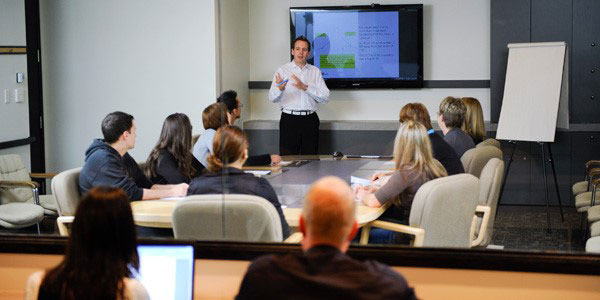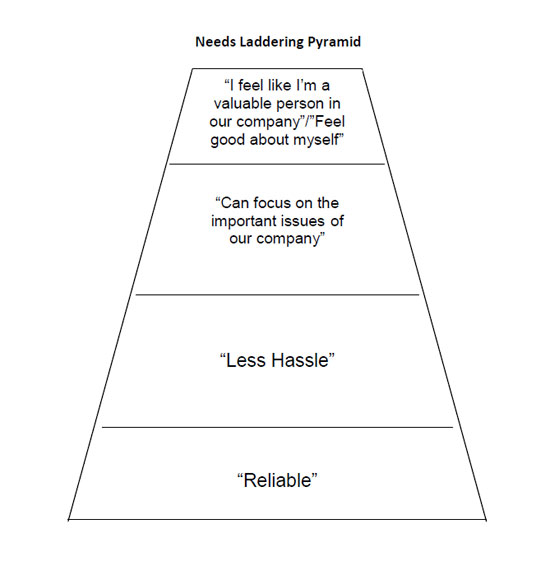 NorthView Research Group offers a wide range of qualitative research techniques. The purpose of qualitative research is to see and hear your target audience discuss the topics of interest in an interactive, dynamic fashion in order to provide more insight, or a different perspective, than can usually be obtained in the rows and columns of numbers generated by a quantitative study.
NorthView Research Group offers a wide range of qualitative research techniques. The purpose of qualitative research is to see and hear your target audience discuss the topics of interest in an interactive, dynamic fashion in order to provide more insight, or a different perspective, than can usually be obtained in the rows and columns of numbers generated by a quantitative study.
We offer the following qualitative research methodologies:
- Focus Groups & Triads
- Online Focus Groups
- Needs Laddering
- Metaphor Groups
- One-on-One Depth Interviews
- Expert Panels
- Executive Interviews
Focus Groups & Triads
The focus group concept originated in clinical psychology as a device to get people to “open up” through the synergy or dynamic that only group discussions can create. Anyone who has been in “brainstorming sessions” in their company knows that they can be a great source of ideas and solutions to problems, as one thought can generate an idea, which in turn generates another idea, and so on. It’s this same type of dynamic that makes focus group discussions so effective for many types of research studies. New product testing and advertising testing are two very common types of research for which focus groups are used in order to gather valuable feedback and generate ideas.
Triads are very small group discussions (triads are three participants, but also refer to any group of 5 or less), that are conducted at the end of a project, such as when only specific refinements to a new product concept, or a communication campaign, are needed. In such cases brainstorming and new ideas are not the objective; instead, the focus is on specific and in-depth feedback, which is more difficult to obtain when 10-12 people are talking as in a larger focus group. Thus, the number of participants is pared down and the focus is on eliciting specific, in-depth, well-thought out answers to just a few areas of questioning. The result of these types of discussion sessions is very focused, in-depth and clear feedback which typically provides very specific direction for the company.
Online Focus Groups
Online focus groups bring the advantages of online technology into the arena of the traditional focus group. Whereas prior to the Online focus group participants, the moderator and the observers had to all be in the same location, with web technology we now have the ability to conduct focus groups without the need for all the parties to be in the same location. Participants, the moderator, and the client can all be literally anywhere in the world, as long as they have access to the web.
In online focus groups, like traditional in-person focus groups, visuals can be presented to the participants.
Two additional advantages with online focus groups is that transcriptions are automatically recorded, and participants can add in written thoughts and comments, in addition to the verbal ones they are giving, which adds to the amount of feedback provided during the group.
Online Communities
Online communities (also called purposed online communities, or MROC’s) for marketing research have come a long way in the past few years, and have now become a valid and valuable method for collecting research information quickly and at low cost.
These communities are put together either by the company or organization, or are outsourced to online community providers, such as digsite.com. These communities are comprised of either customers or members, and are asked to discuss specific topic areas, and/or asked to answer specific questions, so that the conversations are specific to a topic the company needs feedback on. Thus, these communities are more like traditional market research. The benefits of purposed online communities are that researchers can gather a large amount of information quickly, and it is fairly inexpensive once it is set up.
NorthView Research Group can provide either a turnkey solution for your online community, or we can consult with you on setting on up for your company.
Needs Laddering
Needs laddering is a technique that springs from the work of Abraham Maslow and his concept of self-actualization. In needs laddering, a small number of target customers are interviewed in groups typically of three to five individuals by a moderator experienced in this approach. The moderator probes for motivations, feelings and values regarding the purchase process of the particular product or service category being explored. Through the course of the group, the respondents’ associations with the product are gradually elevated from basic characteristics (for example, for software products, IT managers may say “reliable”) through personal benefits and values relating to the experience (for example, “reliable” may lead the respondent to ‘less hassle in my day-to-day work’, then to ‘less hassle helps me maintain my focus on the important issues of our company’), and finally to some form of validation (“I feel smart,” or “I feel like I’m a valuable employee and person in our company”). In the analysis phase, a decision tree structure is created that visually maps the core user associations.
The result of this in-depth examination leads to the identification of the optimum position for a company by illustrating the range of customer-relevant characteristics of the experience, from the very literal to the emotional and subjective. In creating company messages, it is these emotional and subjective needs, rather than the basic needs, that are much more powerful in generating interest, sales and customer loyalty.

Metaphor Groups
Metaphor groups are the creation of Gerald Zaltman, and are a very interesting method for digging deeper and drawing out the kinds of feelings that are typically missed in focus groups but are nonetheless extremely important to finding out why people buy certain products and not others.
Respondents are recruited and asked to spend one to two weeks thinking about how they would visually represent their experience with a company, product or service. They are also asked to find images from magazines, the web, or other easily obtained media, that in some way convey those experiences. Once these images are gathered by the respondents, they are asked to come in to the research facility and, in a small group or one-on-one setting with a trained interviewer, tell stories about the images. This method can be very effective because it gets past the surface discussion and delves into much more deep-seated emotions. These emotions are often what truly drives a purchase decision, even though people may not even realize it, and thus can be very valuable for companies to identify. Focus groups may not reveal these types of deeper emotions, and thus would miss key components in building communications messages and branding strategies.
One-on-One Depth Interviews
One-on-one depth interviews have become much more popular in recent years, as an alternative to focus groups. These interviews are very much like focus groups in that the respondents are interviewed in a relaxed setting, in person with the interviewer. The difference, of course, is that only one respondent is interviewed at a time. There are several reasons why one-on-one depth interviews can have advantages over focus groups:
- The respondent is not influenced by the need to conform to group norms or to avoid embarrassment for “unusual” responses.
- The respondent is the sole focus of the interviewer’s attention and therefore is more likely to open up.
- Because of the intense involvement of the interviewer, the respondent is highly focused and therefore often yields richer feedback.
- Other types of interviews are brief, and in a focus group each individual has a very limited amount of time to speak. In a depth interview, the respondent has 30 or more minutes to talk about the topic.
Expert Panels
Marketers and engineers often have the need for customer feedback that goes deeper than the typical satisfaction survey or new product concept tests among a random group of product category users. What is needed is the type of “expert” feedback, from an “early adopter” set of product category users, that can help the marketer or engineer to see beyond just the next incremental change to a new version of a product or service that gives it a distinct competitive advantage; or, which even creates a whole new product category.
In Geoffrey Moore’s Crossing the Chasm he defines “early adopters,” or “visionaries,” as “that rare breed of people who have the insight to match an emerging technology to a strategic opportunity, the temperament to translate that insight into a high-visibility, high-risk project, and the charisma to get the rest of their organization to buy into that project.” These early adopters, or visionaries, thus, are exactly the types of people who can provide marketers and product developers a wealth of outstanding information to help them develop products that keeps them ahead of the competition.
Expert panels are a group of these “early adopters” (or mavens/salespeople) who have agreed to be “on call” for the client company to provide expert feedback and opinions on current products, new product prototypes, strategic product direction (i.e., new markets for current products) and big picture “pie in the sky” brainstorming on new product concepts.
By using these outside experts to provide ongoing insight into usage behavior, and the needs and wants of users, ideas on product enhancements or new product ideas, and other third-party expert feedback, a company can help to assure itself of staying ahead of the curve and maintaining their competitive advantage.
Executive Interviews
These are interviews conducted with “C”-level executives – CEO’s, CIO’s, COO’s, Presidents, etc. Talking to top-level decision makers provides unique insights that can’t be obtained in talking to other managers or to customers. These decision makers are paid to think ahead and anticipate trends in their industry and in the economy at large. Thus, the information obtained provides excellent information on the “big picture” trends so that a company can build a framework for strategy.
These interviews can be done either over the phone or in the executive’s office.
